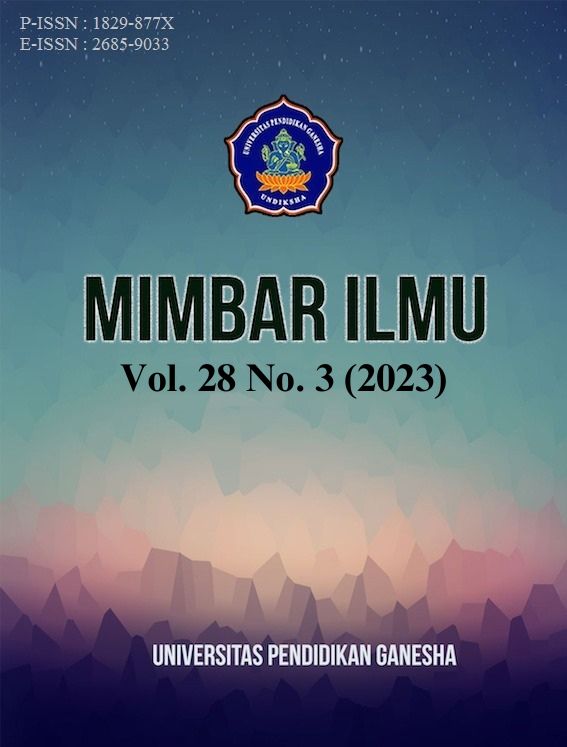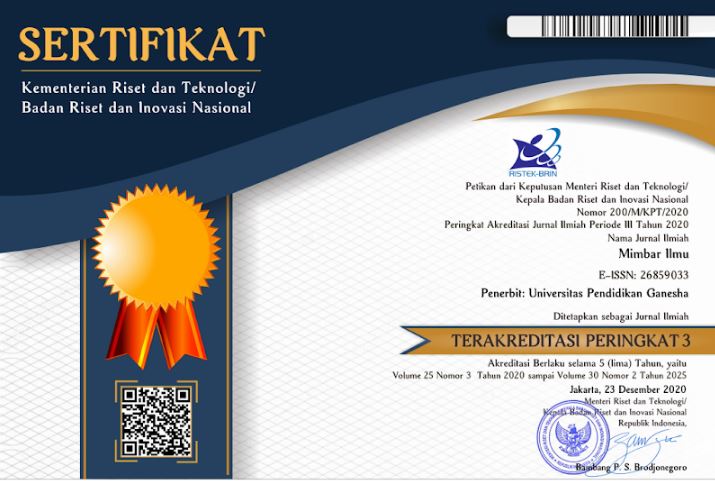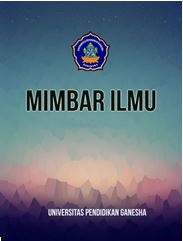Social Media Based Marketing Model to Improve School Reputation
DOI:
https://doi.org/10.23887/mi.v28i3.71140Keywords:
MAS SOLMED, School Marketing, ReputationAbstract
The non-optimal implementation of school promotions, as well as the lack of interactive social media-based school marketing models and guidelines, have an impact on the school's poor reputation. This research aims to develop an interactive social media-based marketing model to improve the school's reputation. This type of research is development research using mixed methods. The development model used is Borg and Gall. Product validation was carried out by 2 IT experts and two management experts. The product trial subjects are teachers, employees, students and parents. Data collection methods include interviews, document studies, questionnaires, observations and focus group discussions. Data collection instrument with questionnaire sheet. Data analysis techniques use qualitative and quantitative descriptive analysis. Process the model effectiveness trial data using the T-test on SPSS 21. The results of the research are the development of a marketing model with IT expert validation of 78% in the very feasible category. Assessment from management experts 90% is a very worthy category. The results of trials on research subjects regarding the model and guidelines for its use averaged 92% in the very feasible category. The product effectiveness test stated that treatment influenced the results in the experimental group. It was concluded that the social media-based marketing model and marketing guidebook "MAS SOLMED" and its guidelines could be used to improve the school's reputation. The implication of this research is that the development of a social media-based marketing model and marketing guidebook "MAS SOLMED" along with the guidelines that have been developed can be used to maintain and improve the school's reputation.
References
Andrew N. Mason, J. N. & K. M. (2021). Social media marketing gains importance after Covid-19. ogent Business & Management. https://doi.org/10.1080/23311975.2020.1870797. DOI: https://doi.org/10.1080/23311975.2020.1870797
Aynie, R. Q., Hurriyati, R., & Dirgantari, P. D. (2021). Strategi pemasaran electronic word of mouth pada e- commerce dalam menghadapi era digital 4 . 0 di indonesia Electronic word of mouth marketing strategy on e-commerce in facing the digital era. Inovasi, 17(1), 136–143. https://doi.org/10.29264/jinv.v17i1.8483.
Barcelos, R. H., Dantas, D. C., & Sénécal, S. (2018). ScienceDirect Watch Your Tone : How a Brand ’ s Tone of Voice on Social Media In fl uences Consumer Responses ☆. Journal ofInteractive Marketing, 41, 60–80. https://doi.org/10.1016/j.intmar.2017.10.001. DOI: https://doi.org/10.1016/j.intmar.2017.10.001
Boko, A. Y., & Sibua Amrin. (2021). Manajemen Berbasis Sekolah: Sejarah dan Strategi Implementasi pada Satuan Pendidikan. Jurnal Ilmiah Wahana Pndidikan, 7(7), 329–338. https://doi.org/10.5281/zenodo.5717447.
Butarbutar, V. M. D., & Ismanto, B. (2022). Evaluasi Pemasaran Jasa Pendidikan Tinggi Keguruan dan Ilmu Pendidikan Perguruan Tinggi. Jurnal Mimbar Ilmu, 27(3). https://doi.org/10.23887/mi.v27i3.48792. DOI: https://doi.org/10.23887/mi.v27i3.48792
Chawla, Y., & Chodak, G. (2021). Social media marketing for businesses: Organic promotions of web-links on Facebook. Journal of Business Research, 135. https://doi.org/10.1016/j.jbusres.2021.06.020. DOI: https://doi.org/10.1016/j.jbusres.2021.06.020
Constantinides, E., & Stagno, M. C. Z. (2011). Potential of the social media as instruments of higher education marketing: A segmentation study. Journal of Marketing for Higher Education, 21(1), 7–24. https://doi.org/10.1080/08841241.2011.573593. DOI: https://doi.org/10.1080/08841241.2011.573593
Damayanti, S. P., Khamidi, A., & Karwanto, K. (2021). Private Junior High School Marketing Management to Face the New Students Admission (PPDB) Policies of State Junior High School in Surabaya. International Journal for Educational and Vocational Studies, 3(1), 64. https://doi.org/10.29103/ijevs.v3i1.3389. DOI: https://doi.org/10.29103/ijevs.v3i1.3389
Dwivedi, Ismagilova, E., Hughes, D. L., Carlson, J., Filieri, R., & Jacobson, J. (2021). Setting the future of digital and social media marketing research: Perspectives and research propositions. International Journal of Information Management, 51. https://doi.org/10.1016/j.ijinfomgt.2020.102168. DOI: https://doi.org/10.1016/j.ijinfomgt.2020.102168
Erlangga, R., & Amidi, A. (2019). Hubungan antara Segmentasi Demografis dengan Keputusan menggunakan Media Sosial. Jurnal Ilmu Manajemen, 9(2). https://doi.org/10.32502/jimn.v8i2.1823. DOI: https://doi.org/10.32502/jimn.v8i2.1823
Hamid, R. A., & Ismail, I. R. B. (2021). Penggunaan Media Sosial di Tempat Kerja dan Tingkah Laku Inovatif Pekerja dalam Kalangan Milenial. Jurnal Pengurusan, 61, 95–108. DOI: https://doi.org/10.17576/pengurusan-2021-61-08
Hanaysha, J. . (2017). Impact of Social Media Marketing, Price Promotion, and Corporate Social Responsibility On Customer Satisfaction. Jindal Journal of Business Research, 6(15), 1–14. https://doi.org/10.1177/2278682117715359. DOI: https://doi.org/10.1177/2278682117715359
Handayani, B., & Ismanto, B. (2020). Evaluasi Manajemen Pemasaran Jasa Pendidikan Nonformal Pusat Kegiatan Belajar Masyarakat. MSP (Jurnal Manajemen dan Supervisi Pendidikan), 4(2). https://doi.org/10.17977/um025v4i22020p083. DOI: https://doi.org/10.17977/um025v4i22020p083
Handayani, C. M. S., Wibowo, T. S., & Prabowo, T. A. (2020). Media Sosial dan Pendidikan Kewirausahaan Pengaruhnya Terhadap Minat Berwirausaha Mahasiswa Program Studi Manajemen. Majalah Ekonomi, 25(2). https://doi.org/10.36456/majeko.vol25.no2.a2941. DOI: https://doi.org/10.36456/majeko.vol25.no2.a2941
Harwani, Y., Suharjo, B., Nurmalina, R., & Supyaritno, G. (2018). Minat Pemilihan Perguruan Tinggi dan Peran Kelompok Referensi Serta Komunikasi Pemasaran Terintegrasi. MIX: Jurnal Ilmiah Manajemen, 8(2), 186–207. https://doi.org/10.22441/mix.2018.v8i2.001. DOI: https://doi.org/10.22441/mix.2018.v8i2.001
Hattu, M., & Ngabalin, A. M. (2023). Strategi Pemasaran Pendidikan dalam Meningkatan Mutu Sekolah di SMP Negeri 9 Ambon. Edukasia Jurnal Pendidikan dan Pembelajaran, 4(3). DOI: https://doi.org/10.17977/um065v3i52023p384-393
Itani, O. S., Agnohotri, R., & Dingus, R. (2017). Social Media Use In B2b Sales And Its Impact On Competitive Intelligence Collection And Adaptive Selling: Examining The Role Of Learning Orientation As An Enabler. Industrial Marketing Management, 66, 64–79. https://doi.org/10.1016/j.indmarman.2017.06.012. DOI: https://doi.org/10.1016/j.indmarman.2017.06.012
Jonathan, G., & Iriani, A. (2021). Evaluasi Kualitas Jasa Sekolah Dasar Dengan Model Servqual Untuk Menangani Penurunan Jumlah Peserta Didik. Jurnal Administrasi dan Manajemen Pendidikan, 4(1). https://doi.org/10.17977/um027v4i12021p51. DOI: https://doi.org/10.17977/um027v4i12021p51
Kustiarini. (2022). Implementasi POAC Pada Penerimaan Peserta didik Baru masa Pandemi Covid 19 di Sekolah Dasar Islam Terpadu. Jurnal Cakrawala Pendas, 8(2). https://doi.org/10.31949/jcp.v8i2.2103. DOI: https://doi.org/10.31949/jcp.v8i2.2103
Liu, K., & Sun, X. Q. (2020). Research on the Development and Innovation of Animation Industry in Jilin Province in the Internet Big Data Era Research on the Development and Innovation of Animation Industry in Jilin Province in the Internet Big Data Era. International Conference on New Energy and Sustainable Development. https://doi.org/10.1088/1755-1315/619/1/012073. DOI: https://doi.org/10.1088/1755-1315/619/1/012073
Margareta, R. T. E., Ismanto, B., & Sulasmono, B. S. (2018). Strategi Pemasaran Sekolah Dalam Peningkatan Minat Peserta Didik Berdasarkan Delta Model. Kelola: Jurnal Manajemen Pendidikan, 5(1), 1–14. https://doi.org/10.24246/j.jk.2018.v5.i1.p1-14. DOI: https://doi.org/10.24246/j.jk.2018.v5.i1.p1-14
Marta, R. F., & William, D. M. (2016). Studi Terpaan Media Pemasaran Melalui Posting Instagram Terhadap Ekuitas Merek Pelanggan Sumoboo! (Analisis Eksplanatif pada Komunitas Food Blogger #WTFoodies). Jurnal Komunikasi, 8(1). https://doi.org/10.24912/jk.v8i1.50.
Mershad, K., & Wakim, P. (2018). A Learning Management System Enhanced with Internet of Things Applications. Journal of Education and Learning, 7(3), 23. https://doi.org/10.5539/jel.v7n3p23. DOI: https://doi.org/10.5539/jel.v7n3p23
Mukhtar, M. (2017). Pemasaran Dan Upaya Dalam Mempengaruhi Harapan Stakeholder Dalam Lembaga Pendidikan Islam. Tarbawi: Jurnal Pendidikan Islam, 4(2). https://doi.org/10.34001/tarbawi.v14i2.621. DOI: https://doi.org/10.34001/tarbawi.v14i2.621
Munarsih, M., Akbar, M. F., Ariyanto, A., Ivantan, I., & Sudarsono, A. (2020). Pelatihan Digital Marketing Dalam Meningkatkan Kompetensi Siswa Untuk Berwirausaha Pada Smk Muhammadiyah Parung - Bogor. Jurnal Pengabdian Dharma Laksana, 3(1), 22. https://doi.org/10.32493/j.pdl.v3i1.6275. DOI: https://doi.org/10.32493/j.pdl.v3i1.6275
Munir. (2018). Manajeman Pemasaran Pendidikan dalam Meningkatkan Peserta Didik. jurnal manajemen pendidikan islam, 1(2622–6162).
Nurhayati, N., Angkarini, T., & Tanamal, N. A. (2021). Students’ perception of teachers’ creativity in implementing home learning at SMK Duta Mas. Scope : Journal of English Language Teaching, 5(2), 90. https://doi.org/10.30998/scope.v5i2.8655. DOI: https://doi.org/10.30998/scope.v5i2.8655
Nurkolis, N., & Muhdi, M. (2020). Keefektivan Kebijakan E-Learning berbasis Sosial Media pada PAUD di Masa Pandemi Covid-19. Jurnal Obsesi : Jurnal Pendidikan Anak Usia Dini, 5(1), 212. https://doi.org/10.31004/obsesi.v5i1.535. DOI: https://doi.org/10.31004/obsesi.v5i1.535
Paduppai, A. M., Hardyanto, W., Hermanto, A., & Yusuf, A. (2019). Pengembangan Sistem Informasi Manajemen dalam Peningkatan Mutu Layanan Pendidikan dan Android di Era Revolusi Digital (Society 5.0 dan Revolusi Industri 4.0). Prosiding Seminar Nasional Pascasarjana (PROSNAMPAS), 2(1), 84–89.
Prayoga, K. (2017). Pemanfaatan sosial media dalam penyuluhan pertanian dan perikanan di Indonesia. Agriekonomika, 6(1), 32–43. https://doi.org/10.21107/agriekonomika.v6i1.2680. DOI: https://doi.org/10.21107/agriekonomika.v6i1.2680
Purnamasari, D. (2018). Pengaruh Lingkungan Kerja Dan Disiplin Kerja Terhadap Kepuasan Kerja Guru Sekolah Menengah Kejuruan (Smk) Swasta Sekecamatan Pondok Aren. Jurnal Saintika Unpam : Jurnal Sains dan Matematika Unpam, 1(1), 108. https://doi.org/10.32493/jsmu.v1i1.1607. DOI: https://doi.org/10.32493/jsmu.v1i1.1607
Rahardja, U., Lutfiani, N., & Amelia, S. (2019). Creative Content Marketing In Scientific Publication Management In Industrial Era 4.0. Aptisi Transactions on Management (ATM), 3(2), 168–178. https://doi.org/10.33050/atm.v3i2.991. DOI: https://doi.org/10.33050/atm.v3i2.991
Saputra, A., & Fauzi, M. (2022). The Role Of Digital Marketing For The Indonesian Inclusive Boarding School. International Jurnal of Innovatif Techologies In Sosial Science, 2(34). https://doi.org/10.31435/rsglobal_ijitss/30062022/7825. DOI: https://doi.org/10.31435/rsglobal_ijitss/30062022/7825
Sartika, D. (2019). Perencanaan Strategi Pemasaran Jasa Pendidikan Sekolah Tinggi Ilmu Tarbiyah (STIT) Simeulue Aceh Melalui Pendekatan Bauran. Idarah (Jurnal Pendidikan dan Kependidikan), 3(2), 1–15. https://doi.org/10.47766/idarah.v3i2.557. DOI: https://doi.org/10.47766/idarah.v3i2.557
Sugiyono. (2016). Metodologi Pendidikan. Alfabeta.
Turmudi, M., & Fatayati, S. (2021). Komunikasi Pemasaran Jasa Pendidikan. Indonesian Journal of humanities and social scienes, 2(1). https://doi.org/10.33367/ijhass.v2i1.1910. DOI: https://doi.org/10.33367/ijhass.v2i1.1910
Varga, E. I. (2020). How does the internet influences the readers’ behavior. Procedia Manufacturing, 46, 949–956. https://doi.org/10.1016/j.promfg.2020.05.013. DOI: https://doi.org/10.1016/j.promfg.2020.05.013
Zulfiah, E., Putri, N. N. N., & Fadhilah, M. (2023). Strategi Pemasaran Jasa Pendidikan dalam Meningkatkan Minat Masyarakat Masuk Sekolah Dasar Islam Terpadu. Ideguru: Jurnal Karya Ilmiah Guru, 8(3). https://doi.org/10.51169/ideguru.v8i3.606. DOI: https://doi.org/10.51169/ideguru.v8i3.606
Downloads
Published
How to Cite
Issue
Section
License
Copyright (c) 2023 Naumi Ambarwati

This work is licensed under a Creative Commons Attribution-ShareAlike 4.0 International License.
This work is licensed under a Creative Commons Attribution-ShareAlike 4.0 International License.
Authors who publish with this journal agree to the following terms:
- Authors retain copyright and grant the journal right of first publication with the work simultaneously licensed under a Creative Commons Attribution License that allows others to share the work with an acknowledgment of the work's authorship and initial publication in this journal.
- Authors are able to enter into separate, additional contractual arrangements for the non-exclusive distribution of the journal's published version of the work (e.g., post it to an institutional repository or publish it in a book), with an acknowledgment of its initial publication in this journal.
- Authors are permitted and encouraged to post their work online (e.g., in institutional repositories or on their website) prior to and during the submission process, as it can lead to productive exchanges, as well as earlier and greater citation of published work.









